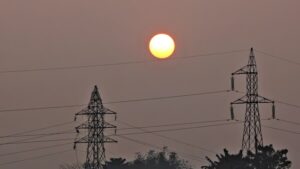Physical Address
23,24,25 & 26, 2nd Floor, Software Technology Park India, Opp: Garware Stadium,MIDC, Chikalthana, Aurangabad, Maharashtra – 431001 India
Physical Address
23,24,25 & 26, 2nd Floor, Software Technology Park India, Opp: Garware Stadium,MIDC, Chikalthana, Aurangabad, Maharashtra – 431001 India

India’s scorching heatwaves in 2024 are doing more than just raising mercury levels—they’re significantly driving up the country’s electricity usage. According to a new analysis by the independent think tank Ember, roughly one-third of the increase in India’s power demand this year can be attributed directly to heatwave conditions. The study sheds light on how climate change is reshaping energy consumption patterns in the world’s most populous nation, with growing implications for infrastructure, policy, and public health.
Soaring Temperatures Push Electricity Demand
This year, many Indian states witnessed unusually hot conditions as early as March, with temperatures climbing beyond 40°C in some regions. As a result, millions turned to air conditioners, coolers, and fans to cope with the heat, leading to a surge in electricity demand. What’s particularly concerning is that these temperatures came before the official onset of summer, suggesting that India’s cooling needs are starting earlier and lasting longer each year. The trend reflects how vulnerable urban and rural areas are to rising temperatures.
Ember’s analysis shows that around 34% of the rise in power usage from March through early April came from heat-related conditions. These days, when temperatures were significantly above average, households, businesses, and institutions relied heavily on cooling systems. The findings shift how energy planners must think about peak demand—no longer tied solely to economic growth but increasingly to weather patterns and human comfort needs.
Coal Steps in as Renewables Lag Behind
Despite steady growth in solar and wind capacity, the surge in demand during heatwaves was met mainly by coal-fired power plants. The report indicates that nearly 89% of the additional electricity generated to meet this demand came from coal sources, while renewables played only a minor role. This highlights a deeper reliance on traditional energy sources during emergencies or periods of rapid consumption spikes, even as cleaner options grow.
This development highlights the gap between India’s clean energy ambitions and on-ground realities. Although the country has committed to increasing its share of renewables, challenges like storage limitations and lack of real-time integration with the grid have made it difficult for clean sources to handle sudden jumps in electricity use. Experts believe that unless storage technology is scaled quickly, renewables may continue to fall short during moments when they’re most needed.
Preparing for a Warmer Future
Ember recommends that India urgently strengthen its power system to handle climate-related stresses. This includes speeding up investment in storage solutions such as battery systems and pumped hydro facilities that supply electricity when demand peaks. Without building this flexibility into the grid, India may face supply gaps and increased pressure on fossil fuel resources during heatwaves.
At the same time, making cooling more efficient—through better appliances, innovative building designs, and community-level solutions—can ease the pressure on the grid. As the frequency and duration of heatwaves continue to grow, these changes will be essential to avoid overloading the system while ensuring people can stay safe and comfortable. Improved public awareness around energy-efficient cooling and subsidies for low-income households could also help reduce overall power strain during high-temperature periods.
The connection between extreme heat and power demand becomes clearer each summer. The report is a timely reminder that India’s energy strategy must now consider rising temperatures a central factor. Meeting growing energy needs while staying aligned with climate goals will require more power generation and more thoughtful planning and investment in future-ready systems. If not addressed, the compounding effect of heatwaves on electricity could threaten energy security and public well-being.
References:
Banner image:
Photo by Debabrata Hazra on Unsplash
Comments are closed.
Some genuinely interesting points you have written.Helped me a lot, just what I was searching for : D.